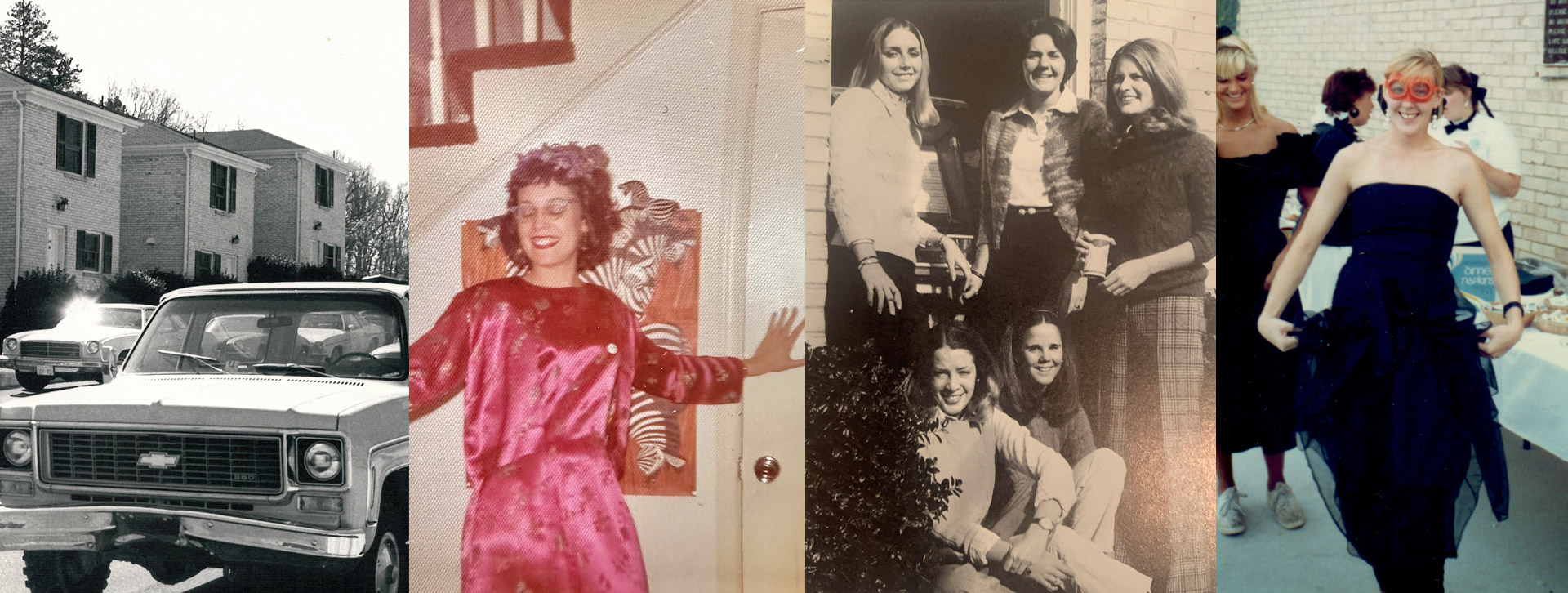Right Across the Street
Alumnae Share Memories of the Williamson Road Apartments Era
By Sarah Achenbach ’88
The road to Hollins looks a bit different now. When you drive down Williamson Road to the campus gates, a familiar landmark is gone. In early June, row by row, brick by tannish-yellow brick, the Hollins apartments were razed, marking an end of an era for college housing and generations of Hollins apartment dwellers.
From 1969 through the 1990s, the apartments were a coveted housing option. Seniors vied to live there. (Juniors, too, at the beginning and end of the apartments era.) Weeks leading up to the spring housing lottery, friends on Hollins Abroad made frantic overseas calls to gather roommate groups and give row preferences.
Living in the apartments is one of my favorite Hollins experiences (during the 1987-88 academic year I resided in Apartment 202). If the Facebook query I posted as research for this article asking for memories and stories about apartment living is any indication, I am not alone.
Before we stroll down memory lane (or rows, since we’re talking about the apartments), a little history is in order.
How It Started
When the apartments were constructed in 1967, they weren’t originally part of the Hollins campus. Roanoke developer Warren Wingfield built the 32-unit Hollins Village Apartments as rental properties next to the parcel of land Hollins owned along Williamson Road. A year later, under some financial duress, Wingfield approached President John A. Logan Jr., to see if Hollins had any interest in using the apartments for student housing.
 At the February 1968 Board of Trustees meeting, Logan and the trustees discussed “…the possibility of having some 20 or 30 mature students live off campus in noncollege housing.” The prospect of nearly 120 more beds meant more students and increased revenue. It also meant happier upperclasswomen. First-year students lived in the new Tinker House, dedicated in April 1966, but upperclasswomen squeezed into other residence halls. A 1968 President’s Interim Report to the Board cites “overcrowding and submarginal housing of a sizeable number of students has produced problems of morale.”
At the February 1968 Board of Trustees meeting, Logan and the trustees discussed “…the possibility of having some 20 or 30 mature students live off campus in noncollege housing.” The prospect of nearly 120 more beds meant more students and increased revenue. It also meant happier upperclasswomen. First-year students lived in the new Tinker House, dedicated in April 1966, but upperclasswomen squeezed into other residence halls. A 1968 President’s Interim Report to the Board cites “overcrowding and submarginal housing of a sizeable number of students has produced problems of morale.”
The Board decided against the leasing option, voting in October 1968 to purchase the Hollins Village Apartments for $575,000, complete with an outdoor pool, and the 500 feet of undeveloped property abutting Williamson Road. The apartments enabled Hollins to grow its enrollment steadily from 885 in 1968 to 1,000 in three years, a significant accomplishment given the declining college enrollment nationally at the time.
The apartments remained popular with seniors for years, but as the new century approached, the units began to show their age. Hollins filled in the pool in the mid-1990s due to liability reasons. Deferred maintenance issues totaled roughly $5 million, explains Kerry Johnson Edmonds ’88, executive vice president and chief operating officer (and one of the few first-year students to go to the fall 1984 opening Apartment Party at the invitation of her sister, Kelly Johnson Storck ’85.)
“After 2000, we saw a significant change,” she notes. “Students wanted to be back on campus.” Seniors now jockeyed to live in the renovated Hill Houses. Hollins began housing more juniors and sophomores on campus, but new issues emerged: The stretch of Williamson Road in front of the apartments was now a busy four-lane thoroughfare, and student safety had become a major concern.
What had been modern housing in the 1970s and 1980s was now tired and cramped—and with the same This End Up furniture that had been there for 30 years. “We started talking about what to do with the apartments in 2011,” Edmonds says. The solution was constructing the new, spacious Student Apartment Village on campus on the original footprint of Faculty Avenue. The 10 homes in the Village, Phase I of which opened in 2019, cover the 92 beds from the apartments and bring the entire student body onto campus.
The apartments did have a late-act last gasp during the COVID-19 pandemic. In spring 2020, international students lived there. “We were able to cluster students there, each with their own room, and not have students scattered through campus, which we had closed,” Edmonds explains. The apartments served as isolation and quarantine housing through Spring Term 2022.
Not Quite Real Life but Real Close
“Definitely different, definitely grown-up,” is how Elizabeth “Zibby” Brady Andrews ’73 recalls apartment life. She and two other juniors ended up rooming with senior Marcy Grill ’73, who had a good lottery number. “It was highly unusual for juniors to be there. Our other junior friends were quite jealous of the lack of supervision [in the apartments] and would stop by often.”
Sure, we were doing the same things across the road that we’d done in the dorms—playing Pictionary on the floor, typing papers on typewriters, putting off studying by smoking cigarettes and talking—but it felt like “we were out of school and in a city apartment,” Margaret “Meg” Joyner Robinson ’88 remembers.
Margaret “Marjie” Wasson ’95 lived in 303 as a junior and 204 as a senior. “The apartments were so much more than just a crazy start to the school year,” she says. “They provided the space to have get-togethers and parties plus more freedom and gave us a taste of post-college living.” Even parking in the rows between the apartments was adult-level, with a series of mini-hills that tested even the most advanced parallel parker.
It was a taste of real-life living without the bitter parts. No threat of starvation (we could still eat every meal in Moody Dining Hall if we chose). Couldn’t be evicted for not paying rent. If it got too loud, we could go to a friend’s apartment or head to the library or Botetourt to study.
Friends would come and go through the apartments to hang out, borrow clothes, or, because I was an R.A., borrow one of the communal vacuums. (Maybe there was one in each apartment. I don’t remember much about cleaning.) On Tuesday night at 10 p.m., we’d cram into our living room to watch thirtysomething on ABC. In the morning, we’d walk across the road for classes with whomever had the same class schedule, sometimes in our pajamas. Many nights at 1 a.m., I’d walk back alone from Botetourt, through the stillness of campus and the sounds of crickets near the creek.
A few might not have used the kitchen, save for the refrigerator (“No Name, No Claim” was the rule for Tabs and beer in the fridge), but many did. Meg and her roomies ate late-night Texas cheese fries prepared by proud Texan Julie Boswell Holmquest ’88. Judy Morrill ’84 happily grilled on a hibachi on her apartment’s patio. And my roommate Kim Shaw ’88 prepared a full-course, from-scratch turkey dinner in our apartment kitchen for our parents on Parents Weekend.
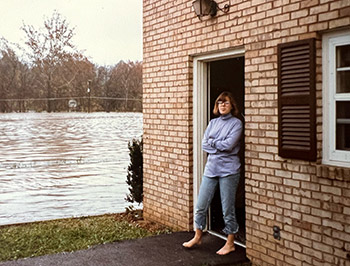
Amanda Miller ‘86, standing outside
her apartment following the flood of
November 1985.
Mary Kate Vick Fuller ’88 wrote of warming up a pizza with Kelly Neill Klein ’88—in the box, which caught fire. “How the hell didn’t we know better?” she asks. But that was part of the real-life learning about basic kitchen safety and some cross-cultural exploration. “Kelly taught me to make chicken-fried steak and called it a ‘Texas Thang!’” adds Fuller, who was elected president of the apartments. It came with a cool plaque on her door but few other duties, she recalls.
Sometimes real life got too close. Amanda L. Miller ’86 and Nicole Osborne Ash ’86 had a second-row, two-person unit directly across from the swimming pool. Their “water-adjacent” locale took on new meaning in November 1985 when Roanoke and Hollins flooded. “Normally, I walked to campus but had driven that morning,” Miller writes. “The rain was picking up considerably, and my clothes were very wet after my first class. I decided to head back to the apartment to change. In the short time between returning to the apartments and preparing to leave again, Route 11 became a river. I watched as classmates struggled to cross the rising water. It didn’t take long before we were completely cut off from the main campus. As the flood water approached, we headed up to apartments on higher ground.”
Designing Women
There were strict rules prohibiting painting the walls, but that didn’t stop people. Jennifer “Jenn” Sgro Orfield ’95 and her roommates painted their entire kitchen ADA purple. “I can only imagine how many layers of paint were needed to cover it up,” she says.
Apartment 203 adorned their kitchen with colorful handprints, recalls Ann Holden Harris ’84. They also recreated entire bedrooms in the rows as a prank. For those too nervous to paint the walls, the half-wall bookcase between the dining area and living area—“open-concept living” pre-HGTV—was fair game for paint, stencils, and other personalization.
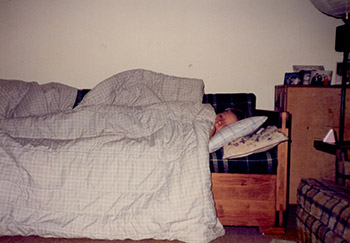
Kim Shaw ’88 in her Apt. 201 bedroom, which was also the living room. (Note sturdy This End Up furniture.)
A few people recovered the cushions of the iconic This End Up sofas and chairs found in each apartment. Rumor has it that the furniture was sold to Hollins at a deep discount, thanks to Caroline Showalter Hipple ’77, who was an executive with the company for 20 years. True? I couldn’t verify it. But what is irrefutable is the furniture’s loungeability, standability, danceability, and, in the case of my apartment, sleepability.
When I was at Hollins, there was a popular bumper sticker: “Preserve Wildlife: Date a Hollins Girl.” There was certainly wildlife at the apartments. Zibby Brady Andrews and her roommates had a large fish tank—approved by residential life—with one large fish. Named Paul after Andrews’ roommate’s ex-boyfriend, the fish tried to escape while Andrews was alone in the apartment. She eventually caught him in a strainer and dumped him back in the tank. It was not Paul’s first offense. He had eaten the other fish, named Mr. Cunningham after the Hollins English professor. Neither fish’s name was a term of endearment.
There were also a few unapproved furry residents. Mary McKibbon ’88 got her kitten Chester early in senior year. He got locked in the dishwasher and refrigerator and had his tail slammed in the door. With accident-prone apartment life eating into his nine lives, McKibbon took him home at Christmas.
Life of the Party
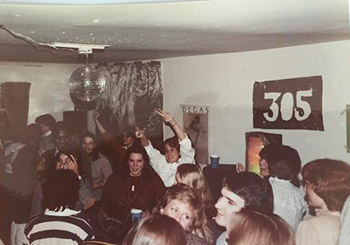
’80s apartment party in 305
The parties, naturally, were legend, particularly the Apartment Party that kicked off the school year. Held a few days before classes started, it was a huge street party with big crowds between the rows. People roamed in and out of apartments and dingy stockade fences for the kegs on the patios. Music blared from various apartments. Boys from around Virginia and farther south traveled to Hollins for it.
Once, I was at a conference and making small talk with the panelist before a conference session. He was a University of Virginia graduate, and I mentioned that I had gone to school in Virginia at Hollins. “Great Apartment Parties,” was his reply.
Some apartments kept the party going. Nancy Crichlow ’82 had one job in spring 1981: secure Apartment 305. Her intended roommates—Laura Jackoway Ludvigsen ’82, Sally “Bumpy” Donnelly ’82, and Nancy Wright ’82—were abroad, and she was the only one who could snag “Studio 305,” so dubbed a few years earlier for its great parties.
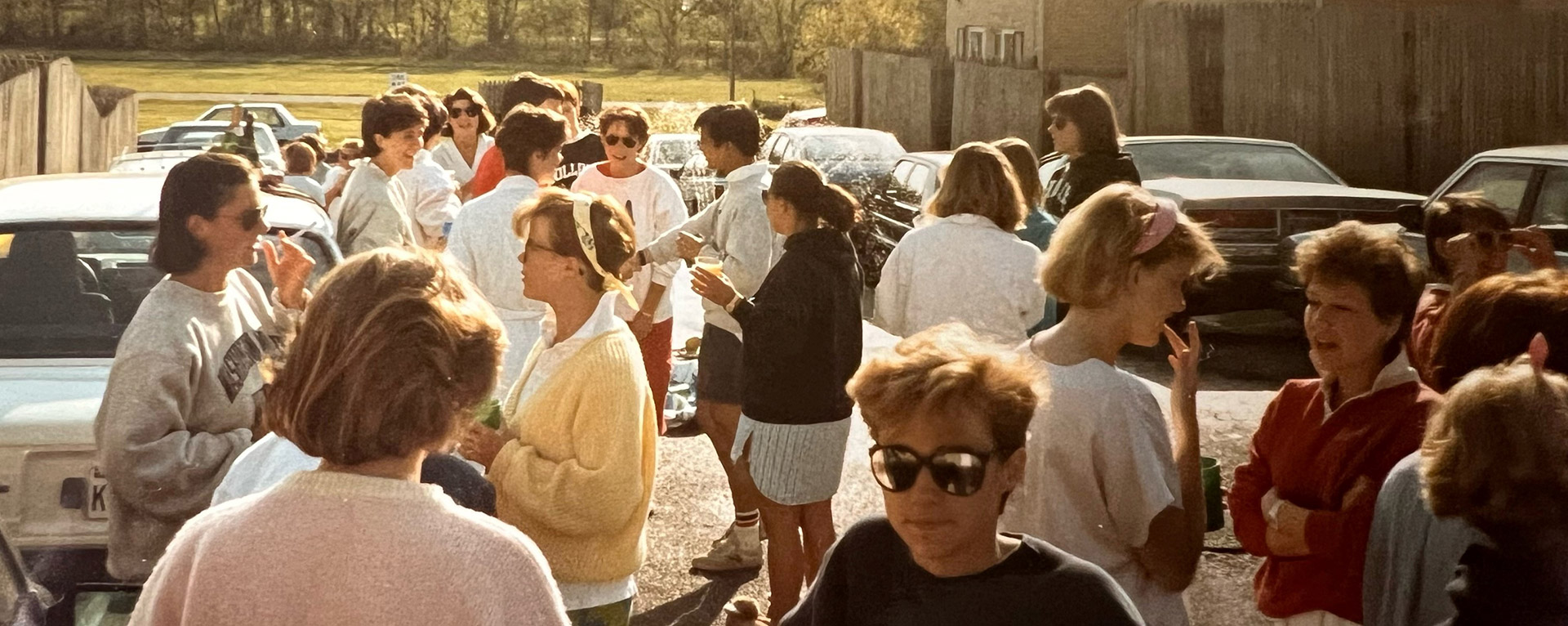
Early Friday morning of Cotillion Weekend, spring 1986. “Lanz nightgowns and sweatshirts were very popular,” noted Amanda Miller ’86.
“I’m convinced Housing Director Jo Ferguson took pity on me for having spent three years in Tinker and rigged the draw,” Crichlow says. “The telegram (!) sharing the good news with London read ‘Studio 305 wildness all (h)ours.’”
Studio 305 parties featured a disco ball, nacho Doritos, peanut M&Ms, screwdrivers, and a living room dance floor crammed with students from all Hollins classes as well as faculty, staff, and the Roanoke community. Studio 305 had a DJ in the closet under the stairs, who played Michael Jackson, David Bowie, Grace Jones, the Fame soundtrack, and The Go-Go’s.
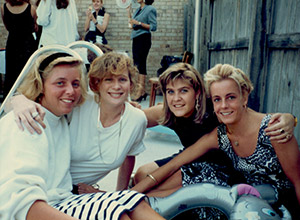
Black and White Pool Party 1988 (left to right) Alison Tainter Gilbert ’88, Kelly Neill Klein ’88, Pam Kauffman Adams ’88, and Barbara Peale ’88.
When the pool was a pool and not a grass plot (after the mid-1990s), it was the place to party or just hang out on a sunny day. The pool was also the scene of what may have been the only student protest at the apartments. And it was unrest over, fittingly, the right to party. Jamie Granger Collier ’87, apartments president, organized the protest after several apartments were denied party contracts following unruly parties in October 1986. The Hollins Columns reported that residents were cited for breaking noise ordinances, sitting on apartment roofs, failing to clean up, and having male guests who publicly urinated and caused property damage when a guest drove in circles on the adjacent Community School’s fields.
Sarah Dowling, the resident coordinator for Back Quad and the apartments, said in the complaint that the apartments in question violated the party rules and/or did not obtain the proper party contract prior to the parties. Any apartment wishing to host a party had to request a party contract approved by Dowling. Understandably, Hollins was concerned about student safety, liability, and adhering to Virginia’s new over-21 drinking age. Following the party weekend in question, five apartments received letters explaining that Dowling would not sign contracts for them for the remainder of the semester.
“That didn’t go over well and we held a ‘protest’ that security had to break up,” Collier recalls. The residents of five apartments stood in solidarity in front of the pool, their radios ready to blast the request they had called into a local radio station: Cyndi Lauper’s “Girls Just Want to Have Fun.”
After a packed community meeting about the issue, both sides reached a compromise. Girls still had fun but just with the correct paperwork.
What’s Next?
Edmonds and Hollins have been working with Roanoke County and the landowner who owns a great deal of real estate leading up to campus on how the university can be the catalyst for development along the Williamson Road corridor.
“There hasn’t been any true development along this part of Williamson Road, yet this area has the largest concentration of employees in North Roanoke County,” she says. Razing the apartments gives Hollins seven acres of land to develop and, as Edmonds explains, “inspire others to better see what could be developed.” Hollins’ plan is to do a long-term land lease to maintain control over the site of the former apartments, which could feature housing and commercial opportunities that could serve Hollins and the region.
Indeed, the apartments have always been about potential. Crichlow sums up what every resident felt: “I remember the heady feeling of being young and hyper-alive, the world at our feet.” Living there, trying on adult life, was part of the education.
“The apartments were where this naive 19-year-old learned most of her close friends were gay when a dear friend’s birthday party turned into a coming-out party of sorts,” Candace Upson McLane ’89 shares. “That night set so much in motion, the Gay Straight Alliance among them, but more importantly, a life full of long-standing authentic sisterhood friendship. It has rippled into my children’s lives, where they have been blessed with so many aunties who care about them. The apartments were where we could share our truths.”
In the months leading up to graduation in 1988, Mary Kate Vick Fuller ’88 and seven friends decided to extend the apartments experience by moving together to a chosen city. They wrote the names of six cities—Atlanta, Dallas, Charlotte, New Orleans, New York City, and Washington, D.C.—on slips of paper and put them in a hat. “We drew one out, and it was D.C.,” she says. “We all got jobs and moved there at the end of the summer after graduating. There were 14 Hollins girls who lived on our street in Old Town Alexandria. Best decision ever that night in the apartments.”

